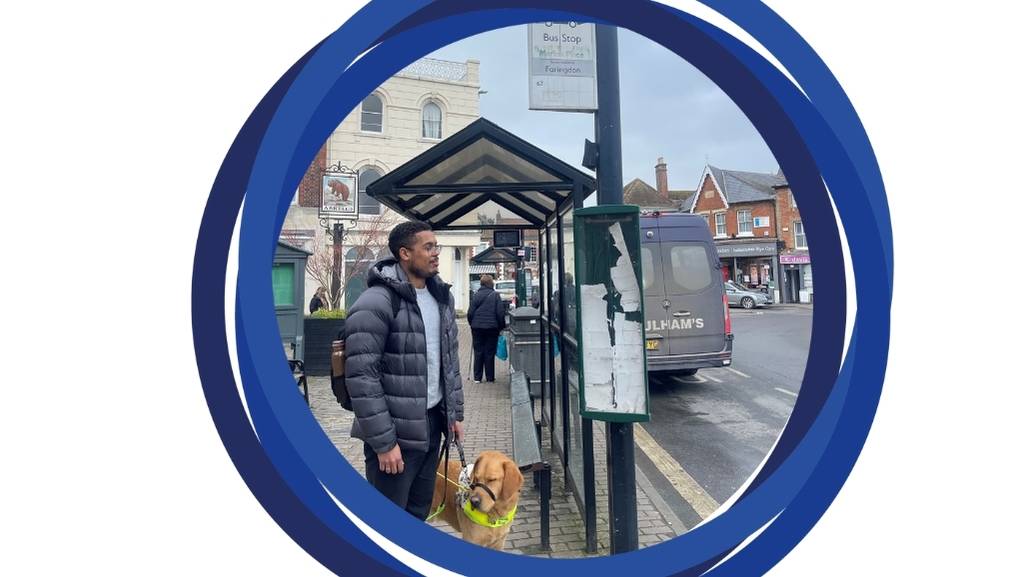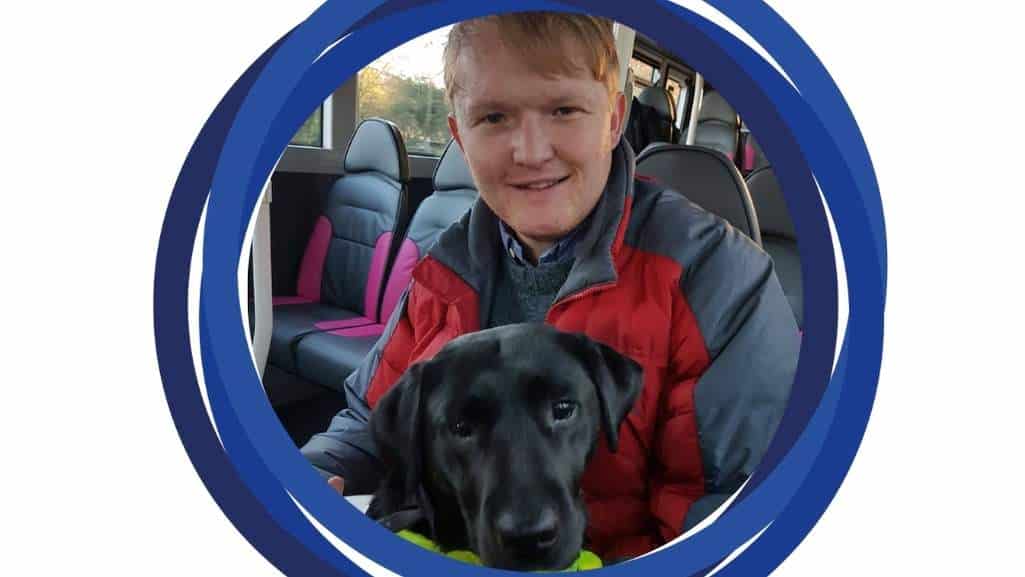How do you commute when you’re visually impaired? There are some methods that are not a viable option such as driving or cycling. Instead, there is a strong reliance on public transport, rides from family/ friends, and walking.
Navigating options such as buses is often not as simple as hopping on and off. However, if you are visually impaired and have ever been dissuaded from travelling around for any reason, we’d like to tell you that it can be done and there are ways to make it accessible and straightforward. Three visually impaired members of our MyVision community have talked to us about their experiences getting around, the tools they use to make travel easier, and if you aren’t visually impaired how you can be more supportive and mindful when sharing public transport.
Devante Claridge
Devante Claridge is our Community Engagement Worker, and he often travels around the county to plan and coordinate various events. He utilises buses, trains, taxis, and sometimes gets lifts from family. He said, “Most public transport can be reliable; however, I find trains and buses can be difficult when there is a delay or a cancellation because there are normally no alternatives.”
In mid-2023 Devante started working with a Support Worker who drives him to different venues to make his commutes more efficient and reliable. “It’s been a huge weight off my shoulders,” he said. “Getting to locations is so much easier and less time consuming. It has also taken away anxiety of not being able to find a place. You also avoid being outside and waiting in all weather conditions.”
Devante still uses public transport regularly and he laid out some ways it could improve: “I wish people would be more aware when sitting in disabled seating as my guide dog needs the space. People should not be leaving food or rubbish on the floor because it is a distraction towards my guide dog and additionally, leaving objects in the middle of the walkway is a very big trip hazard.”
“People also need to be more aware that not every disability is visible. When someone looks like they’re struggling it’s important to assist and not judge, and during rush hour people should be more vigilant and helpful to others.”
Devante’s advice to other visually impaired people travelling is: “plan, predict, and prepare. Plan your journey, predict that there may be delays and prepare; bring a drink or snack, a portable charger, and know where the disabled bathrooms are.”

Aaron Lee
Aaron Lee is an active supporter of MyVision and works for The Thomas Pocklington Trust, an organisation we work closely with.
“In Oxford, during business hours I think public transport is largely reliable,” said Aaron. He found that most of the challenges come during rush hour as the town centre can become very congested. Outside of rush hour there are a reduced number of buses which can then lead to long waiting times.
“I can appreciate the reliability of public transport isn’t an exclusive issue to visually impaired people, but for people with visual impairments it’s often the only means of getting around. It’s not something I think those in charge of running public transport consider,” said Aaron.
“A lot of planning is involved to make sure I know where to get on and off. There aren’t always audio announcements which means if I am going somewhere new, I won’t know where I am. I am okay with routes I use frequently but elsewhere in the city can be more difficult.”
Aaron then said, “I also find it frustrating when people think of public transport as a choice when for some visually impaired people it’s the only option to get around.” Aaron does not feel safe cycling in the city and walking is often not quick or efficient enough. “It’s all well and good implementing new traffic reduction schemes but when they have a negative impact on those who rely on public transport, we are just left stuck in the jam waiting for someone to take notice.”
Aaron’s advice to other visually impaired people when travelling is to utilise your phone and to communicate. “Your phone is your friend. I use my phone to check the Trainline app and as a magnifier to zoom in on dot matrix boards at stations, but also make sure you have a plan B in case your phone dies. I take a portable charger and a pair of binoculars when I go out.”
He then said, “I have found strangers coming up to me to be the most helpful. I recommend making yourself as visible as possible so staff know you are there and may need help. Additionally, you should check with the bus or train company’s enquiry team if there is something you need or want to know such as if there are audio announcements, what stop to get off at, or if there are any diversions you should be aware off.”
“Lastly, if you get off at the wrong stop or don’t know where you are, don’t panic! Take the next train, bus, or tube back the way you came until you find a station name you recognize, or the next large station.”
Nathan Tree
Nathan Tree is our Community Engagement Lead. He travels every day to our office from Wheatley and often travels throughout the county to coordinate various events. He primarily uses buses, walks, and gets occasional lifts from friends and family.
“I get a bus from my home into the centre of Oxford. I then walk for about half an hour with my guide dog to the office. As opposed to getting a bus I choose to walk. Then I’ll do that in reverse in the evening,” said Nathan.
“I live where I live because transport is reliable,” he said. “I choose my transport times so that I’m not stuck in traffic so I’ve engineered it so that it’s reliable. Traffic, however, can still be a problem.”
“My biggest challenges used to be knowing when the bus is coming, knowing which bus it was, and knowing what stop to get off at, but now I can do all of those comfortably. Currently my biggest challenge is finding a seat when it’s busy. Other people often offer a seat and sometimes I stand. If I find myself really needing help, then I ask the driver; people are generally really helpful.”
Nathan then outlined several things he wishes people knew about what travelling as a visually impaired person is like. “You can use apps to work out which bus is coming and when to get off it. We get a free bus pass which works after 9am on weekdays, and we generally do know where we are and where we’re going. Usually, if you see a visually impaired person on a bus they know where they’re going; they’re not guessing.”
Nathan then outlined how commutes can be made more accessible for visually impaired people. “It would be nice if the bus pass was free before 9am as well. It would be great if buses reliably announced which stop they are arriving at, and if there were announcements at the bus stops about what bus is arriving.”
Nathan’s advice to visually impaired people on their commutes is, “there are some very helpful apps for travel. The Oxford bus app, and Moovit are very useful, and for the times you have to pay, you can do it on your phone.” He then said, “The public are generally very helpful. If you have a visual aid it’s much easier to communicate and ask questions.”
Top Tips from Devante, Aaron, and Nathan for getting around with a visual impairment
- Plan your journey.
- Prepare for delays.
- Have a drink, snacks, portable charger, and know where the disabled toilets are.
- Utilise your phone.
- Utilise apps such as the Oxford bus app, Trainline, Magnifiers, and Moovit.
- When you have to pay for transit, you can do it on your phone.
- Make yourself visible to make staff aware you may need help.
- Check with the bus or train company’s inquiry team if there’s something you need or want to know.
- If you get off at the wrong stop, don’t panic. Take the next bus or train the way you came until you recognise a station or reach a large, central station.
- If you have a visual aid, it’s much easier to communicate and ask questions.


